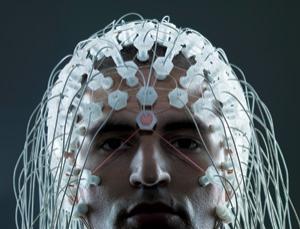
当我们改变自己的脑波的时候会发生什么?
习惯很难被改变,但是现在至少我们知道了习惯是怎么样形成的。
当一组神经元细胞同时“开火”时,这种活动形成脑电波。不同的脑电波频率在大脑中执行不同的任务。
为了跟踪脑电波在学习过程中是如何改变的,马萨诸塞州技术研究所的Ann Graybiel和Mark Howe使用电极来分析小鼠在学习走迷宫是腹侧纹状体中的脑电波。
当小鼠在学习这个任务时,它们的大脑活动显示快速的γ波的爆发。一旦小鼠掌握了该任务,它们的脑电波就降低至最初四分之的频率,变为β波。Graybiel的小组怀疑这种转变反映了从学习到习惯的改变。
Graybiel说较慢的脑电波可能是大脑在清除多余活动以作出准确行为。她认为,在你学习一项技能时,通过加强这类β波的活动来提高学习速度是有可能的。
生物探索推荐英文论文摘要:
Habit learning is associated with major shifts in frequencies of oscillatory activity and synchronized spike firing in striatum
Rhythmic brain activity is thought to reflect, and to help organize, spike activity in populations of neurons during on-going behavior. We report that during learning, a major transition occurs in task-related oscillatory activity in the ventromedial striatum, a striatal region related to motivation-dependent learning. Early on as rats learned a T-maze task, bursts of 70- to 90-Hz high-γ activity were prominent during T-maze runs, but these gradually receded as bursts of 15- to 28-Hz β-band activity became pronounced. Populations of simultaneously recorded neurons synchronized their spike firing similarly during both the high-γ–band and β-band bursts. Thus, the structure of spike firing was reorganized during learning in relation to different rhythms. Spiking was concentrated around the troughs of the β-oscillations for fast-spiking interneurons and around the peaks for projection neurons, indicating alternating periods of firing at different frequencies as learning progressed. Spike-field synchrony was primarily local during high-γ–bursts but was widespread during β-bursts. The learning-related shift in the probability of high-γ and β-bursting thus could reflect a transition from a mainly focal rhythmic inhibition during early phases of learning to a more distributed mode of rhythmic inhibition as learning continues and behavior becomes habitual. These dynamics could underlie changing functions of the ventromedial striatum during habit formation. More generally, our findings suggest that coordinated changes in the spatiotemporal relationships of local field potential oscillations and spike activity could be hallmarks of the learning process.







